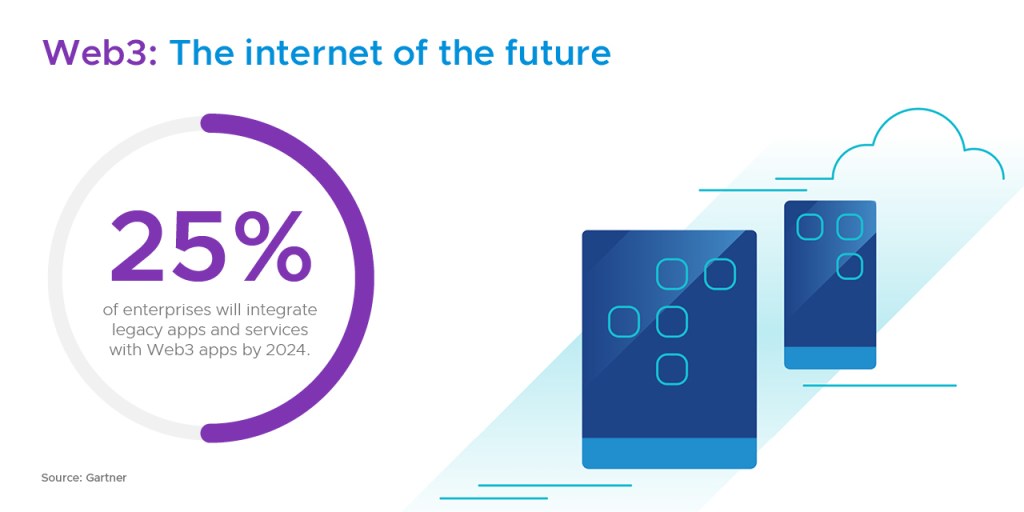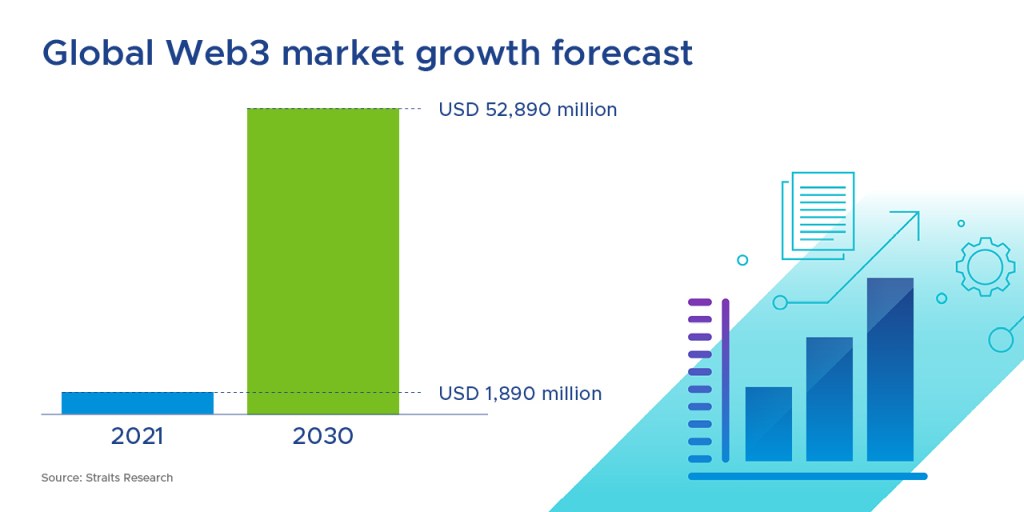In the tech world there is a lot of commentary on Web3. Advocates argue it will set the internet free of its so-called limitations, while detractors say it is just marketing hype and far from becoming a reality.
Web3 is, of course, the vision of the next iteration, or the third generation of the internet. But what is it really? Is it just another technology buzzword, or is it actually taking shape in the real world?
What is Web3 and where did it come from?
At the core of Web3 is the idea of a decentralized internet – a web of peer-to-peer transactions with no reliance on centralized platforms or intermediaries. This marks a significant shift from today’s internet (‘Web2’) which is characterized by user-generated content hosted and aggregated on centralized platforms that are usually owned by large companies (like Meta or Google). Web3’s decentralized nature also means users own and control their content and online identity, and thereby also the privacy of their data and how it is monetized.
Web3’s decentralized model has the potential to fundamentally transform the way we use the internet, but it also has the potential to disrupt business models across industries.
This reality may be closer than we expect. According to Gartner, Web3 technologies are expected to go mainstream in the next decade. By 2024, 25% of enterprises around the world are expected to integrate legacy apps and services with decentralized Web3 applications.

As this new iteration of the internet begins to change the way we do business, enterprises will need to understand how to integrate Web3 technologies into their overall digital strategy. But how exactly does Web3 work?
Web3 technology explained
Web3 uses a stack of technologies based on blockchain. A blockchain is a distributed database that enables secure, transparent, and tamper-proof transactions. A ‘smart contract’ is a program on the blockchain that can automatically execute transactions when the conditions in a protocol are met. This can significantly improve trust in transactions, and at scale, it can potentially boost efficiency by saving time and cutting costs.
Blockchain was originally created as the public distributed ledger for bitcoin transactions. But, like blockchain, Web3 technologies have many enterprise applications beyond cryptocurrency. It is this perceived potential that is driving interest and investments in Web3 technologies. According to Straits Research, the global Web3 market is forecast to grow at a compound annual growth rate (CAGR) of nearly 45% between 2022 and 2030, with Asia-Pacific expected to be the fastest growing market.
Key Web3 use cases
Decentralised Finance (DeFi)
In financial services, Decentralized Finance (DeFi) is an emerging model based on distributed ledgers that can potentially replace services offered by traditional financial institutions. It can enable multi-party transactions to be processed quickly and securely on decentralized applications.
Asia-Pacific organizations are increasingly looking at DeFi implementations. Singapore’s central bank, the Monetary Authority of Singapore, is exploring use cases of digital assets and DeFi on a public blockchain alongside DBS and JPMorgan. DBS itself is looking to use a blockchain-based network for fixed income trading, which will allow the bank to settle transactions in a matter of hours.
Blockchain-based central bank digital currencies
Blockchain-based central bank digital currencies (CBDCs), which are digital tokens issued by a country’s central bank, can promote financial inclusion and simplify the implementation of monetary and fiscal policy. Markets across our region are increasingly considering a CBDC – with China, India, Thailand and Australia leading the way.

Digital payments via stablecoin or crytocurrency
Digital payments via stablecoin or cryptocurrencies are also seeing increased adoption. According to a Deloitte report, nearly 75% of retailers surveyed are planning to accept either stablecoin or cryptocurrency payments within the next two years due to increasing consumer interest. This is leading to the development of Web3 point-of-sale solutions. XPOS Web 3.0 is one such solution, among many other Web3 solutions, that was announced at the 2022 Singapore Fintech Festival.
Decentralised Autonomous Organisations (DAOs)
Web3 can also potentially transform governance models. A decentralized autonomous organization (DAO), a blockchain-based governance model, is collectively owned and managed by its stakeholders. DAOs have the potential to transform the way corporate governance works by improving transparency levels. For example, a DAO in Melbourne, Australia could soon help revitalize parts of the city. In the media world, non-fungible tokens (NFTs) are already enabling artists to control their own digital creations on a blockchain, and share directly with their audience.
Web3 needs a robust blockchain platform
To prepare for the decentralized future, enterprises need to first invest in blockchain solutions that can make multi-party transactions efficient and secure, while establishing trust and maintaining privacy.
An enterprise-grade blockchain platform that is scalable and meets an organisation’s unique needs can provide a strong foundation.
Bursa Malaysia, one of the largest stock exchanges in ASEAN, is utilizing such a platform for the dematerialization of securities. Other examples are a vital records management solution developed by Infosys which leverages VMware Blockchain for Ethereum to enable seamless verification and authentication of records in a transparent and completely secure manner. Or Broadridge Financial Solutions which is using distributed ledger technology to increase efficiency and maintain a competitive edge, while operating responsibly in a highly regulated environment. Another great example is The Bank of Israel, which is exploring blockchain’s privacy-preserving functionality for its Digital Shekel (CBDC) Project.
Getting Web3 ready
Business leaders may have to prepare themselves for disruptions as Web3 technologies further develop in the next few years. It is important for an enterprise to understand which area of its business is likely to be disrupted by Web3. It also helps to keep an eye out for challenger businesses or even existing competitors that are leveraging Web3 and evaluate use cases accordingly.
A feasibility study of the proposed use case can then help examine regulatory, business and technology aspects before commencing its implementation. Partnering with a Web3 solutions provider or an enterprise-grade blockchain platform can then help develop digital assets and deploy them on decentralized applications (dApps). It is also important to upskill your teams – from leadership to developers – on Web3 and its applications in your enterprise.
By integrating a Web3 strategy within the overall digital transformation strategy, an enterprise can be prepared for the impending transition from Web2 to Web3. Those that fail to do so may run the risk of being left behind as these fast-evolving technologies disrupt the business landscape.

